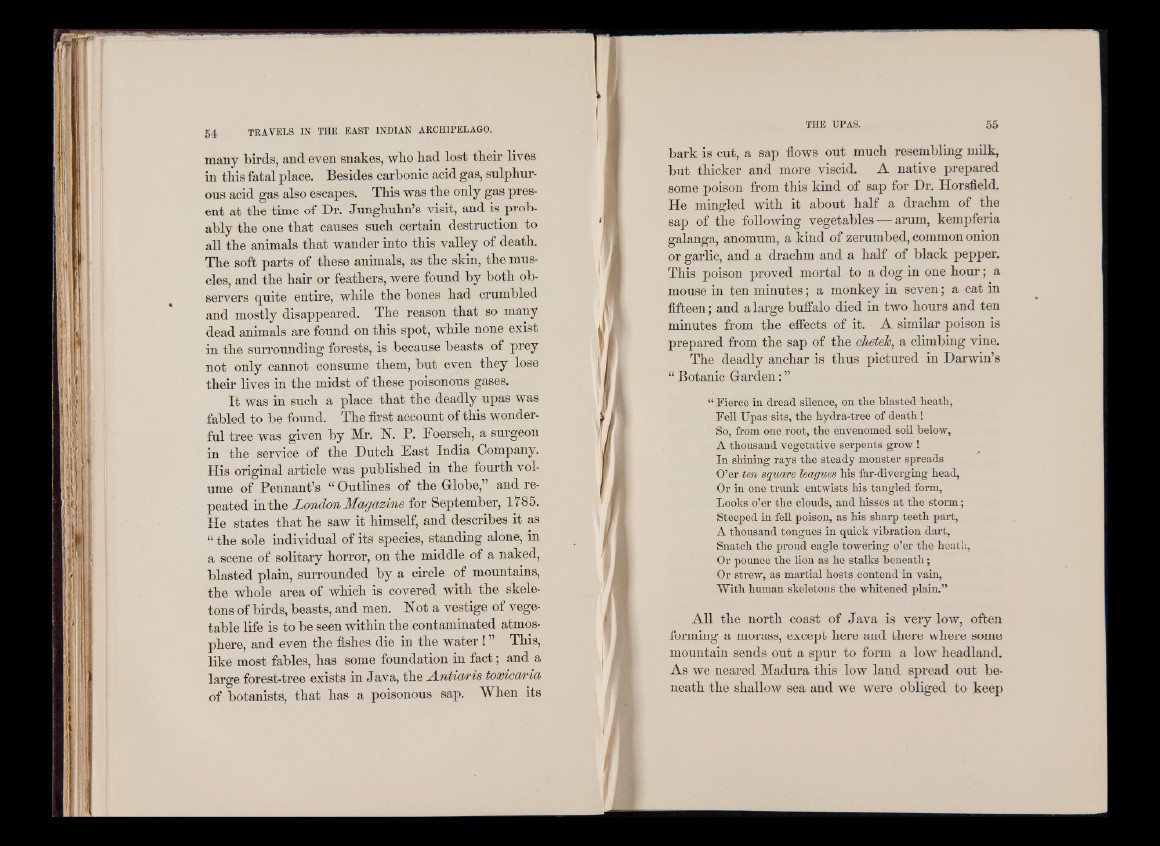
many birds, and even snakes, who had lost their lives
in this fatal place. Besides carbonic acid gas, sulphurous
acid gas also escapes. This was the only gas present
at the time of Dr. Junghuhn’s visit, and is probably
the one that causes such certain destruction to
all the animals that wander into this valley of death.
The soft parts of these animals, as the skin, the muscles,
and the hair or feathers, were found by both observers
quite entire, while the bones had crumbled
and mostly disappeared. The reason that so many
dead animals are found on this spot, while none exist
in the surrounding forests, is because beasts of prey
not only cannot consume them, but even they lose
their lives in the midst of these poisonous gases.
It was in such a place that the deadly upas was
fabled to be found. The first account of this wonderful
tree was given by Mr. H. P. Foersch, a surgeon
in the service of the Dutch East India Company.
His original article was published in the fourth volume
of Pennant’s “ Outlines of the Globe,” and repeated
in the London Magazine for September, 1785.
He states that he saw it himself, and describes it as
I the sole individual of its species, standing alone, in
a scene of solitary horror, on the middle of a naked,
blasted plain, surrounded by a circle of mountains,
the whole area of which is covered with the skeletons
of birds, beasts, and men. Hot a vestige of vegetable
life is to be seen within the contaminated atmosphere,
and even the fishes die in the water ! ” This,
like most fables, has some foundation in fact; and a
large forest-tree exists in Java, the A.nPia/i'is toxicaria
of botanists, that has a poisonous sap. When its
bark is cut, a sap flows out much resembling milk,
but thicker and more viscid. A native prepared
some poison from this kind of sap for Dr. Horsfield.
He mingled with it about half a drachm of the
sap of the following vegetables — arum, kempferia
galanga, anomum, a kind of zerumbed, common onion
or garlic, and a drachm and a half of black pepper.
This poison proved mortal to a dog in one hour; a
mouse in ten minutes; a monkey in seven; a cat in
fifteen; and a large buffalo died in two hours and ten
minutes from the effects of it. A similar poison is
prepared from the sap of the chetek, a climbing vine.
The deadly anchar is thus pictured in Darwin’s
“ Botanic Garden: ”
“ Fierce in dread silence, on the blasted heath,
Fell Upas sits, the hydra-tree of d e a th !
So, from one root, the envenomed soil below,
A thousand vegetative serpents g row !
In shining rays the steady monster spreads
O’er ten square leagues his far-diverging head,
Or in one trunk entwists his tangled form,
Looks o’er the clouds, and hisses at the storm;
Steeped in fell poison, as his sharp teeth part,
A thousand tongues in quick vibration dart,
Snatch the proud eagle towering o’er the heath,
Or pounce the lion as he stalks beneath;
Or strew, as martial hosts contend in vain,
With human skeletons the whitened plain.”
All the north coast of Java is very low, often
forming a morass, except bere and there where some
mountain sends out a spur to form a low headland.
As we neared Madura this low land spread out beneath
the shallow sea and we were obliged to keep